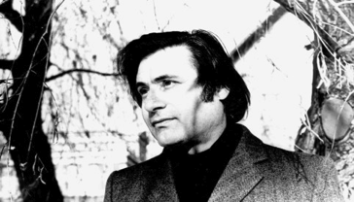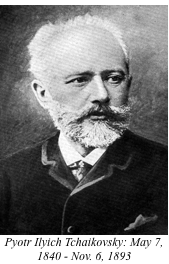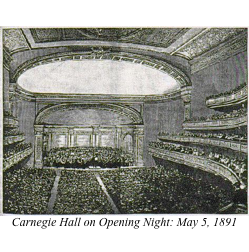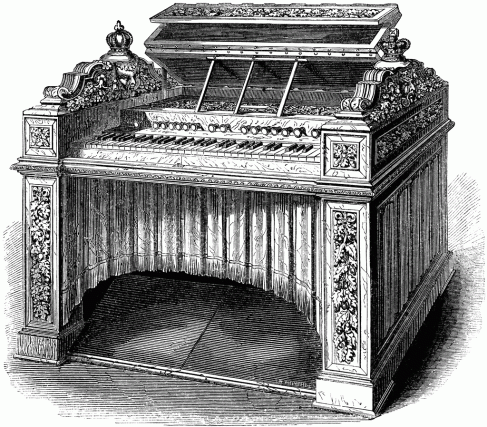Close to his birthday, The Philadelphia Singers will join forces with the Philadelphia Chamber Music Society to perform Gioacchino Rossini’s Petite Messe Solennelle. Take an in-depth look at some highlights as written by Nancy Plum.

Gioacchino Rossini
b. Pesaro, Italy, February 29, 1792
d. Passy, France, November 13, 1868
Petite Messe Solennelle
Gioacchino Rossini was a most unusual composer, compared others in his profession through history. Recognized as the greatest Italian composer of his time while he was alive, and overshadowing such contemporaries as Bellini and Donizetti, Rossini walked away from it all at the age of thirty-seven. Rossini began composing operas around the age of eighteen, and for the subsequent twenty years was an operatic hit-producing machine, composing more than forty by the time of his retirement in 1829. Following the premiere of Guillaume Tell—yet another smash—Rossini called it a day on operatic composition and retired to twenty-five years of poor health and personal loss.
In 1855, Rossini moved with a new wife to Paris, where another musical climate co-existed with the operatic stage. Private salons and chapels in individual homes and estates offered appealing musical opportunities, and Rossini had a second career as a composer of piano works, songs and small ensemble pieces. In the last thirteen years of his life and in this atmosphere of private commissions and samedi soirs, Rossini produced more than 150 works, including Petite Messe Solennelle.
Even in his sixth decade, Rossini did not have a long history of sacred music composition. There were three youthful mass settings, as well as the Stabat Mater, which took eight years to complete. It is unclear what drove Rossini to compose a mass at this point in his life; it may have been commissioned by the Comtesse Louise Pillet-Will, in whose townhouse the work was premiered, but scholars suggest that Rossini’s dedication of the piece to the Comtesse came only after she agreed to underwrite the first performance. It is also possible Rossini was inspired by such contemporary works as Liszt’s Missa Solemnis, which had been premiered in Hungary in 1856. It is equally as plausible that Rossini, feeling mortality lurking nearby, composed the mass as a personal statement of faith. His inclusion of the “O salutaris hostia” prayer in the midst of the standard mass text, as well as his two-month focus on the work (in a career which saw him churn out operas in as few as three weeks) suggest that there may be more to the genesis of this work than a mere commission or keeping up with fellow composers.
French homes and private chapels in the mid-19th century usually contained at least one piano, and often a pipe organ. In spaces where a pipe organ was not possible, the harmonium, a keyboard instrument with reeds sounded by pedal-operated bellows, was often found. The combination of piano and harmonium was especially popular among composers of this era; Liszt had a piano-forte-harmonium self-contained instrument built for his own use. The Pillet-Will private chapel contained both piano and harmonium, and the instrumentation for the premiere performance of Petite Messe Solennelle was for two pianos and harmonium.
In a compositional style directly contrary to the mid-19th century trend toward large choral works for large forces, Rossini specified that a vocal ensemble of “12 singers of three sexes—men, women and castrati—will be sufficient for (the mass’) execution. With a nod toward the kantorei performance practice of Bach’s time, Rossini also specified the four soloists also sing the chorus parts, for a “total of 12 Cherubim.” The theory that this mass is Rossini’s personal statement is supported by his inscription in the score, in which Rossini wrote: “Dear God, forgive me the following comparison: Twelve also are the Apostles in the celebrated coup-de-mâchoire painted in Fresco by Leonardo, called The Last Supper, who would believe it! Among thy Disciples are some who strike false notes! Lord, rest assured, I swear that there will be no Judas at my supper and that mine will sing properly and con amore your praises and this little composition which is, alas, the final mortal sin of my old age.”
Petite Messe Solennelle was premiered March 14, 1864 at the home of Comtesse Pillet-Will, with performing forces slightly different than Rossini’s specifications; the four vocal soloists were joined by fifteen conservatory singers. Rossini led all rehearsals leading up the by-invitation-only premiere, and turned pages for one of the keyboard artists. The piece was an instant success, with publishers and musicians alike calling for Rossini to orchestrate it for large-scale performance. By 1867, Rossini did produce an orchestration which included ophicleide (a 19th-century Parisian brass instrument based on the keyed bugle), harp and organ. Rossini had high hopes for a performance of the newly-orchestrated Petite Messe in a basilica, but with one condition. Not particularly fond of boy singers, Rossini petitioned Pope Pius X to allow female sopranos and altos. This petition was declined, and under criticism that his orchestration of the piece was “old-fashioned” and uninteresting compared to the chamber version, Rossini locked Petite Messe Solennelle away as one of his self-proclaimed péchés de vieillesse (“sins of old age”).
Following Rossini’s death in November 1868, his widow sold the rights to the mass for 100,000 francs, and Petite Messe Solennelle was performed more than sixty times throughout Europe in the subsequent year. Anticipation of this work was building overseas even before its premiere; when word of a new Rossini sacred composition came to New York, the magazine Once a Month published a teasing query under the headline “Rossini’s Mysterious Mass,” stating that “Rossini had positively finished a grand mass with choruses, but declined to permit the execution of the work…is it a Requiem, and for who it is destined? Time will show.”
Petite Messe Solennelle is divided into the five standards movements of the Catholic mass: “Kyrie,” “Gloria,” “Credo,” “Sanctus” and “Agnus Dei,” as well as the interpolated Eucharistic hymn “O salutaris hostia” and the “Preludio Religioso” for harmonium. Like many composers of the 18th and 19th century, Rossini divided the extensive “Gloria” and “Credo” into a series of solos, choruses and small ensembles.
The “Kyrie” of the traditional mass text is tripartite, with two declamations of “Kyrie eleison” bracketing a statement of “Christe eleison.” Rossini sets the opening Kyrie with imitative entries of the choral parts following a harmonium and piano introduction. All voices come together on the word “eleison,” with several choral restatements of the text. The a cappella contrasting setting of “Christe eleison” pays tribute to the 16th-century stile antico style, with entries at intervals of the fourth and fifth.
Rossini again pays homage to the past in the opening of the “Gloria,” providing the traditional incipit, but sets the text for the soprano voice, rather than the customary tenor. Rossini’s setting of the “Gloria” text alternates soloists and chorus in Baroque cantata style, with soloists conveying the more intimate text. The soprano/alto duet on the words “Qui tollis peccata mundi” was originally composed for two of Rossini’s favorite singers who were sisters. The movement closes with a complex fugue (described by some critics after the premiere as the highlight of the piece), recapping material from earlier in the movement.
Rossini set the “Credo” text in fewer sections than the “Gloria,” saving the most important words, “He was crucified for us under Pontius Pilate, suffered and was buried” for solo soprano, the same was as his earlier Stabat Mater assigned the essential “Inflammatus et accentus” text to soprano soloist. Key to the setting of the “Crucifixus” text are the entrances on rising by thirds (climbing higher on the cross) and the drop of a 7th on the phrase “et sepultus est.” A brief foray into C major hints at salvation. The word “Credo” recurs from time to time, sung in block chords by the chorus in a refrain-like technique also used by Beethoven. Like the “Gloria,” the “Credo” ends with a double fugue, much in the style of Haydn-era masses.
An instrumental “Preludio religioso” for harmonium follows the “Credo,” serving as the Offertory In the traditional church service; including such an instrumental interlude or prayer was not uncommon in French masses of the time. This “Preludio,” as well as the “O salutaris hostia” which follows the “Sanctus,” was composed by Rossini earlier in his career and both are included in a previous collection of Rossini’s péchés de vieillesse. The last two verses of the hymn “Verbum supernum prodiens,” “O salutaris hostia” is a portion of a Eucharistic hymn written by St. Thomas Aquinas for the Feast of Corpus Christi and used for the Adoration of the Blessed Sacrament. The closing “Agnus Dei,” like that of Bach’s B minor Mass, is set for contralto solo, with the chorus ending the Petite Messe Solennelle with a homophonic “Dona nobis pacem” in a texture reminiscent of late Schubert.
Rossini also provided an inscription at the end of the manuscript to this his last major choral composition. The composer addressed God that “There you have it, finished, this poor little mass,” and asks “Is it indeed music for the blest (“musique sacrée”) that I have written or blessed music (“sacrée musique”)? Thou knowest well, I was born for comic opera. A little science, a little heart, that is all. So bless Thee and grant me Paradise!” Rossini may have been born for comic opera, but clearly proved just as worthy in the choral arena.

 The young Schnittke came from a Russian family of mixed Jewish and Volga-German descent. His father worked as a journalist and translator, and the family moved often to accommodate his work. As a result, though Schnittke was born in Engels, Russia, his first musical studies were in Vienna as a young teen, then when the family moved again, at The October Revolution Music College in Moscow. In 1953, he entered an undergraduate program at the Moscow Conservatory and continued on to pursue graduate studies with Yevegny Golubev and Nikolay Rakov. In 1962, he was offered a job teaching instrumentation at the Moscow Conservatory and began his career as a freelance composer. He supported himself in large part through writing for theater and film, scoring the first of many films to come in 1965.
The young Schnittke came from a Russian family of mixed Jewish and Volga-German descent. His father worked as a journalist and translator, and the family moved often to accommodate his work. As a result, though Schnittke was born in Engels, Russia, his first musical studies were in Vienna as a young teen, then when the family moved again, at The October Revolution Music College in Moscow. In 1953, he entered an undergraduate program at the Moscow Conservatory and continued on to pursue graduate studies with Yevegny Golubev and Nikolay Rakov. In 1962, he was offered a job teaching instrumentation at the Moscow Conservatory and began his career as a freelance composer. He supported himself in large part through writing for theater and film, scoring the first of many films to come in 1965.






